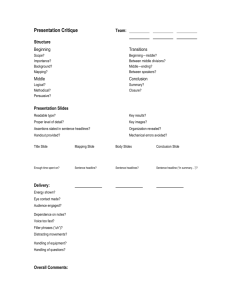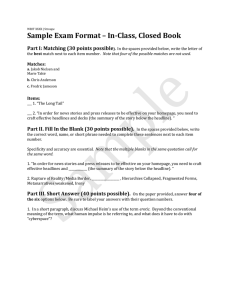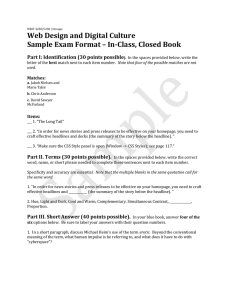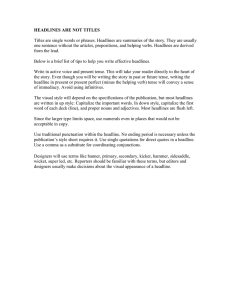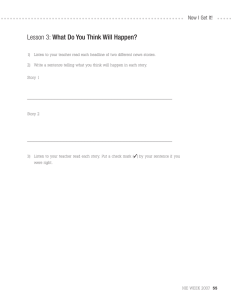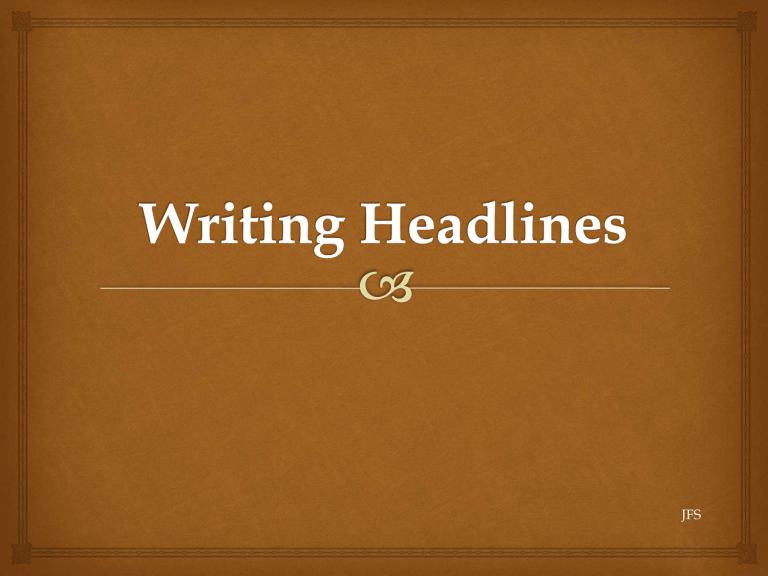
JFS What is a Headline? The headline is the text indicating the nature of the article or news story below it. It’s a brief summary of what is the article about. WHAT IS IT’S PURPOSE ? A headline's purpose is to quickly and briefly draw attention to the story. Functions to tell in capsule form what the story is all about; to grade news as to importance ; and to make the page look attractive Structure of Headlines Flush Left ‐ Both lines are flushed to the left margin. This is also true with a one‐line headline. This has to no exact count for the units in each line. Example: Family planning Seminar held Structure of Headlines Dropline or Step Form ‐ The first line is flushed left while the second line is indented. It may consist of two or three, and sometimes four lines of types of the same length, somewhat less than a column in width , so that the first line is flushed to the left, the second centered , and the third flushed to the right. Example: Local boy scouts bleed for a cause Structure of Headlines Inverted Pyramid ‐ The self‐explanatory. Each of the three or four lines in this head is successively shorter than the line above it. Examples: School launches kalinisan drive Structure of Headlines Hanging Indention ‐ The first line is flushed left. This is followed by two indented parallel lines. Examples: Chief editor bats for more development news Structure of Headlines Crossline or Barline ‐ A one‐line headline that runs across the column. The simplest form, it is a single line that runs across the allotted space. If it runs across the page ‘ it is called a streamer. Example: Local students join Clean drive Structure of Headlines Boxed headline ‐ For emphasis or art’s sake, some headlines are boxed: a.) Full box ‐ Community involvement Science camp theme b.) Half box‐ Campus paper catalyst for national development Structure of Headlines c.) Quarter box ‐ Local students, teachers bleed for a cause today Structure of Headlines Jump Story Headline - A jump story(a story continued on another page) has a headline of it’s own. This may be the same as the original headline or it may be a word, phrase or group of words followed by a series of dots. Headlinese Headlines in English often use a unique set of grammatical rules known as Headlinese. Headlinese is an abbreviated writing style used in newspaper headlines. Do’s and Dont’s in writing Traditional Headlines Do’s Make your headline answer as many W’s as possible. The headline should summarize the new story . It should contain nothing that is not found in the story. Positive heads are preferable to negative ones. Example : School physician allays flu fear is better and shorter than Flu epidemic not rampant in the city. Put a verb expressed or implied in every deck. Do’s and Dont’s in writing Traditional Headlines Omit articles like a, an and the and all forms of verb to be (is, are , be), unless needed to make the meaning clear Examples: Reclaimed banks are causes of recurrent flood (are before causes is not necessary) . Barack Obama is new president (is is necessary to make the meaning clearer.) Do’s and Dont’s in writing Traditional Headlines Use the strongest word in the first line as possible. The active verb is better than the passive verb in headlines. Examples: Local Hi‐ Y aid flood victims But, for variations, and especially when the doer is unknown or not prominent, the passive verb may be used. Examples: Food production drive intensified RP’s lost image abroad regained Do’s and Dont’s in writing Traditional Headlines Use the present tense for past stories and infinitive form for future stories. Examples: President Gloria Macapagal Arroyo bats national reconciliation. Lantern parade to cap X’mas affairs Write numbers in figures or spell it them out depending upon your needs for your unit counts. Do’s and Dont’s in writing Traditional Headlines Use the following headline styles, but be consistent once you have adopted once a. All caps CHARACTER, NATIONALISM VITAL COGS IN EDUCATION b. Cap and lower case Character , Nationalism Vital Cogs in Education c. Down style Character , nationalism vital cogs in education. What to Avoid in Writing Headlines Avoid the following kinds of headlines: a.) Fat Head ‐ the spaces between the letters are so crowded that there are no more space between , them or that the spaces are so small that several words read as one. Examples: BSP LAUNCHES DRIVE b.) Thin Head‐ the spaces between the letters or words or the space after the words in a line are so wide that the effect is ugly. Example: BSPLAUNCHESDRIVE c.) Label Head ‐ an incomplete headline, like the label of a product. Example: CHRISTMAS PARTY d.) Wooden hand‐ a very weak headline that is devoid of meaning, sometimes due to the absence of a subject or the lack of a verb. Example: TO HOLD EXCURSION e.) Mandatory Head ‐ it gives a command because it begins with a verb. Example: HOLD DIALOGUE WITH PRINCIPAL f.) Screaming Head ‐ it is big and bold headline of a short and unimportant story . A sensational head is another kind of screaming headline. What to Avoid in Writing Headlines Don’t tell the same thing even though you use a different word. Each succeeding deck should contribute information. Don’t comment directly or indirectly. Avoid editorializing even in headlines. Unless the subject is implied or has been mentioned in the first deck ,avoid beginning a headline with a verb. What to Avoid in Writing Headlines Don’t end a line with a preposition. Neither should you separate a preposition from it’s object. Do not confuse a hanging preposition with a two ‐word verb that ends with a preposition. Wrong: Students vote for SSG officials (“for” is a hanging preposition) Right: Principal bats for moral values( “bats for” is a two word verb) What to Avoid in Writing Headlines Don’t break off abbreviations, name, and hyphenated words. Avoid repeating principal words regardless of the numer of decks. Aoid heads that carry a double meaning. Don’t coin abbreviations of your qwn. Use only those that are common to the readers like PNRC, DepED, DCS. Don’t abbreviate days and months unless figures follow as: Mon., Jan. 23 Punctuating Headlines A few pointers as regards punctuation of headlines should be observed. As a rule, headlines, just like titles of editorials, features, and literary articles, should not end in a period. Other simple rules follow: Use a comma in place of conjunction and. Self–reliance, discipline up at Baguio confab Two related thoughts should be separated with a semicolon . As much as possible this should be at the end of the line if the headline is a two-line headline or a running head. School joins Operasyon Linis; P.E. – CAT boys drain estero The dash may be used for smaller decks, but not for headlines in large types. The single quotation marks, not the double quotation marks are used in headlines Cultural development: ‘Linggo ng Wika’ theme Unit Counting in Headlines (in Letterpress Printing) Writing headlines is not as simple and as easy as it seems. A headline should fit the allotted space by a system of unit counts given to each letter , figure or space. This is done to avoid a thin head, a fat head ,or a bleeding headline (one that extends out of the column page). The corresponding unit counts are as given as follows: ½ unit- jiltf and all punctuations except the em dash (-----), and the question mark(?) 1unit – the question mark, space, all figures capital JILTF, all lower case letters except jiltf. 1 ½- the em dash, lower case m and w and all capital letters except capital M and W and JILTF. 2 units - the capital M and W , 1 ½ ½ ½ 1 11 ½ 11 1 1 1 ½ 1 1 ½ 1 ½ 1 C i t y S c h o o l s f e t e = 15 ½ 1½1½ 1½ 1½ 1111½ ½ 11 C h i e f E x e c u t i v e= 14 Note: Unit counting in headline is used only in, Letter press Printing. In Computer Printing, there is no need for counting units; the computer does work. Printer’s Direction Printer’s Direction or Specification for Headlines Write a one line headline ,occupying 3 columns, 42 points high bodoni bold type ,cap and lower case. Answer: 3 – 42 –bb -clc Preparing Headline Schedule (For Letterpress Printing) A headline schedule is a complete collection of headline types that are particular newspaper uses. This collection should specify the unit counts for all heads. Headlines Unit Counts Size/Family Type Columns Osmeña High revives comedia 12 14 ½ 48 Radiant 2 Reclaimed banks cause Of recurrent floods 21 17 36 Caslon 2 12 ½ 11 ½ 11 ½ 30 Cheltenham 1 Food production drive intensified 29 24 Century 2 Science journalism caps NSTA seminar 7 9 11 7 Dope upsurge in community, School noted 1 Headline Vocabulary Headline writing must be cartloads of special skill. The copy editor who usually writes the headlines should be able to tell in capsule form – simply, temptingly, yet understandably – the most complex story with words that fit the limit of the unit counts. To do this , he must have cartloads of special words to use for the sake of simplicity, brevity and easy reading. However, certain newspapers terms used in headlines are not acceptable in formal writing or usage, nor do they carry their literal meaning as in the case of idioms.
